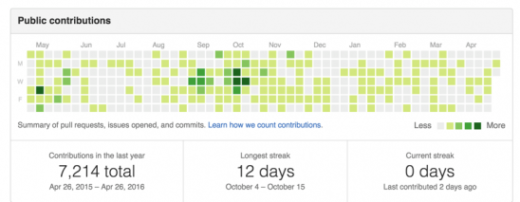 In September 2016, I wrote an op-ed for Harvard Business Review called “We Need a Better Way to Visualize People’s Skills.” In it, I describe a Github of competencies for the workforce, but here’s how the same idea would translate into higher education.
In September 2016, I wrote an op-ed for Harvard Business Review called “We Need a Better Way to Visualize People’s Skills.” In it, I describe a Github of competencies for the workforce, but here’s how the same idea would translate into higher education.
George McCully wrote recently in “Pushing Back on Higher Education as Trainer for High-Tech Jobs” (The New England Journal of Higher Education, June 21, 2016): Education certainly includes training, but is both broader and deeper, intensely personal and social—focusing on the cultivation of values. Education is more about who, training is more about what, students are and will become in their subsequent lives and careers.
The debates between vocational/technical training and education are getting old. On one side, we have academics arguing for the timelessness of an education—learning that is not specifically tailored toward work or “the what,” as McCully calls it. On the other side, we have employers retreating more and more from training candidates and blaming institutions for the sad state of potential hires.
Discussions about knowledge, skills and abilities—and the skills gap writ large—inevitably devolve into a dichotomy of “hard” and “soft” skills. Somehow, institutions of higher education teach those soft skills and the ability to learn how to learn for a lifetime. Jobs, on the other hand, teach you hard skills—implying a narrower kind of learning experience. Critics argue that employers should therefore own all training by keeping workers au courant of “useful knowledge and skills” for our rapidly evolving markets. College is much better-suited, as McCully argues, for the “permanent and characteristic mission of higher education,” or things that do not go “in and out of fashion with changes in economies or technologies.”
But these distinctions don’t help anyone—least of all, the student. Both employers and schools must enable people to skill up in both ways. By 2020, the U.S. economy will create 55 million job openings; 24 million will be entirely new positions. Many of these jobs (48%), according to Georgetown University’s Center on Education and the Workforce, will be less physically intensive and instead emphasize skills like active listening as well as leadership, communication, analytics and administration competencies.
We need a GitHub for competencies in education and the workforce.

Anyone in tech will recognize this grid as a GitHub profile. GitHub is a social-networking site for web developers to collaborate on open-source code management. It’s a way for developers to display their revisions of public repositories of code. The darker the green, the more a person has contributed to the platform. No one hires a developer without looking at his or her GitHub profile.
Imagine having a GitHub profile of competencies. An employer could immediately, visually take in the depth of a candidate’s profile in different areas—both her foundational skills as well as her other technical skillsets. What if we could click on that darker colored square in the grid and immediately view artifacts from the candidate’s past experiences that best illustrate that competency? Or, in other cases, we might see that a company or institution validated that particular competency. A profile of competencies with the visual impact of a GitHub profile would make immediately clear to employers a candidate’s capacity and potential. At the same time, each person would similarly be able to identify his or her own skills gaps that need to be filled.
Competencies demonstrate precisely what students can do: This person can apply financial principles to solve business problems; this person can write memos by synthesizing data from multiple sources; or this person can evaluate web resources. If we can do a better job of identifying and making obvious a person’s important skillsets and competencies and making that translation clearer between education providers and employers, we might be able to send clearer signals in the market without having to rely solely on the blunt instrument of a college diploma.
The good news is that we don’t need to start from scratch.
Last year, Burning Glass Technologies crawled through millions of job postings and identified the soaring demand by employers for what they call “baseline” skills.

Source: Burning Glass Technologies, “The Human Factor: The Hard Time Employers Have Finding Soft Skills” (Nov. 2015)
This table is not unlike a GitHub profile. In their report “The Human Factor: The Hard Time Employers Have Finding Soft Skills, the Burning Glass authors identify the ranked foundational skills by career area. The depth of color is tied to the most valued or most commonly requested skill: “On average, one in three skills requested in job posting is a ‘baseline skill,’ which include “people” skills, writing, and Microsoft Word and Excel.” These baselines skills tend to cluster into six main areas: 1) Presentation and persuasion; 2) Customer service; 3) Attention to detail and time management; 4) Positive disposition; 5) Project management, research and strategy; and 6) Supervisory skills.
There are disparate, other resources that classify competencies in similar clusters. As early as 1986, Stark, Lowther, and Hagerty of the University of Michigan classified competencies in similar clusters. In their extensive literature review, they identified six professional competencies: conceptual competence, technical competence, contextual competence, interpersonal competence, integrative competence, and adaptive competence.
In 1991, the U.S. Labor Secretary’s Commission on Achieving Necessary Skills published key employment skills that included: basic skills (reading, writing, arithmetic and mathematics, speaking, and listening), thinking skills (thinking creatively, making decisions, solving problems, seeing things in the mind’s eye, knowing how to learn, and reasoning), and personal qualities (such as developing individual responsibility, self-esteem, sociability, self-management and integrity).
The National Network of Business and Industry Associations, which accounts for 75% of the projected job growth by 2020, came together in order to agree on common employability skills. Representing the manufacturing, retail, healthcare, energy, construction, hospitality, transportation, business and information-technology sectors, these associations landed on four key areas: 1) Personal (integrity, initiative, dependability/reliability, adaptability, professionalism); 2) People (teamwork, collaboration, respect); 3) Applied Knowledge (reading, writing, math, scientific, technology, critical thinking; and 4) Workplace Skills (planning & organizing, problem-solving, decision-making, business fundamentals, working with tools/technology, customer focus).
Many of these skills in demand appear to overlap and coincide with the competencies often identified as safe within the realm of academia, or the who of education as McCully parses. We need some sort of infrastructure to undergird the power of competencies and competency-based education (CBE), as a “Rosetta Stone” with common terms of reference. Instead, the more than 600 CBE university providers that have emerged over the past few years are all building programs differently and defining competencies differently. We run the risk of having hundreds or thousands of competencies that sound different but essentially mean the same thing.
We need a GitHub for competencies to lay the groundwork for a marketplace that does not depend solely on the degree as a proxy for talent. We know that liberal arts competencies are powerful enablers in the workforce, but we need more precise ways of proving it. Most employers use the degree as a screen or general sorting mechanism that may not relate to the jobs’ duties. All of this imprecision has led to the demand for higher and more degrees for jobs that don’t really require a degree in the first place. A can-do-hub would re-set the long-broken dialogue between industry and education and enable more direct connections between our students and the jobs that they desire.
Michelle R. Weise is executive director of the Sandbox ColLABorative, the research and development lab of strategy and innovation at Southern New Hampshire University.
Related Posts:
The Case for Competency-Based Education: A New Age of Teaching and Learning?
Learning to Do During High Unemployment
[ssba]
